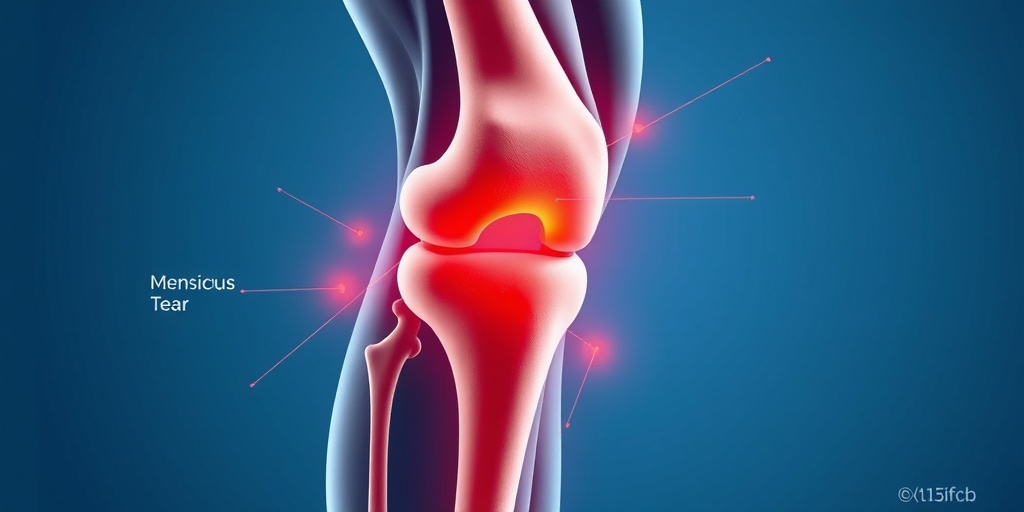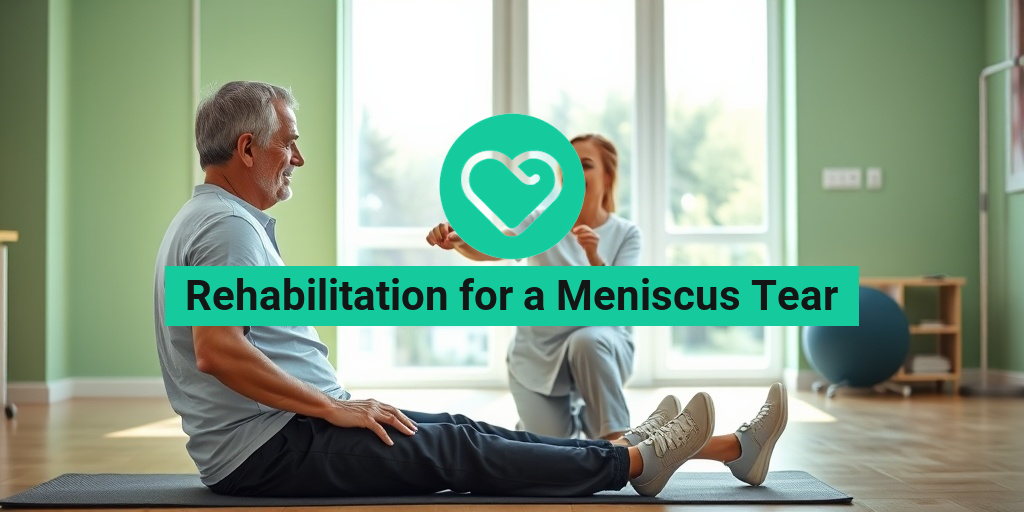What Is a Meniscus Tear?
A meniscus tear is a common knee injury that occurs when the cartilage in the knee joint is damaged. The meniscus is a C-shaped piece of cartilage that acts as a cushion between the thigh bone (femur) and the shin bone (tibia). It plays a crucial role in stabilizing the knee and absorbing shock during movement. Meniscus tears can happen due to various reasons, including sports injuries, degenerative changes due to aging, or even simple activities like squatting or twisting the knee awkwardly.
There are two types of meniscus tears: medial meniscus tears and lateral meniscus tears. The medial meniscus is located on the inner side of the knee, while the lateral meniscus is on the outer side. Understanding the type of tear is essential for determining the appropriate rehabilitation for a meniscus tear and treatment options.
Causes of Meniscus Tears
Meniscus tears can occur due to:
- Sports Injuries: Activities that involve sudden stops, twists, or changes in direction, such as basketball, soccer, or skiing, can lead to tears.
- Aging: As we age, the meniscus can become weaker and more prone to tears, even with minimal stress.
- Accidents: Falls or accidents that put excessive pressure on the knee can also result in a meniscus tear.
Meniscus Tear Symptoms
Recognizing the symptoms of a meniscus tear is crucial for timely treatment and rehabilitation. Common symptoms include:
Pain
Pain is often the first noticeable symptom. It may be localized to the area of the tear and can worsen with movement or weight-bearing activities. The intensity of the pain can vary depending on the severity of the tear.
Swelling
Swelling around the knee joint is another common symptom. This swelling may develop gradually over a few hours or days following the injury.
Stiffness
Individuals with a meniscus tear often experience stiffness in the knee, making it difficult to fully bend or straighten the leg. This stiffness can be particularly pronounced after periods of inactivity.
Locking or Catching Sensation
Some people report a sensation of the knee “locking” or “catching,” which occurs when a torn piece of cartilage interferes with the normal movement of the joint. This can be quite uncomfortable and may require medical attention.
Difficulty Bearing Weight
Many individuals find it challenging to bear weight on the affected leg. This can lead to a compensatory gait, which may cause additional strain on other joints.
When to Seek Medical Attention
If you experience any of these symptoms following a knee injury, it’s essential to consult a healthcare professional. Early diagnosis and treatment can significantly impact the effectiveness of rehabilitation for a meniscus tear and help prevent further damage.
For those seeking more information on treatment options, including physical therapy for a meniscus tear and exercises for a meniscus tear, resources like Yesil Health AI can provide evidence-based answers tailored to your needs.
In conclusion, understanding what a meniscus tear is and recognizing its symptoms can empower you to take the necessary steps toward recovery. Whether through conservative treatment options or surgical intervention, effective rehabilitation is key to regaining full function and returning to your daily activities. 🏃♂️💪

Causes of Meniscus Tears
The meniscus is a C-shaped cartilage in the knee that acts as a cushion between the thigh bone (femur) and the shin bone (tibia). Meniscus tears can occur due to various reasons, and understanding these causes is crucial for effective rehabilitation for a meniscus tear. Here are some common causes:
1. Sports Injuries
Many meniscus tears are the result of sports-related injuries. Activities that involve sudden stops, twists, or changes in direction—such as basketball, soccer, and football—can put excessive stress on the knee joint, leading to tears. 🏀⚽
2. Age-Related Degeneration
As we age, the meniscus can become weaker and more prone to injury. Degenerative meniscus tears often occur in older adults, even without a specific injury. This type of tear is usually a result of wear and tear over time, making it essential to consider treatment for a degenerative meniscus tear for older individuals.
3. Direct Trauma
A direct blow to the knee, such as from a fall or collision, can also cause a meniscus tear. This type of injury is common in contact sports or accidents, where the knee is subjected to sudden force.
4. Overuse and Repetitive Stress
Repetitive activities that place stress on the knee joint can lead to meniscus tears. This is particularly common in athletes who engage in high-impact sports or individuals whose jobs require frequent kneeling or squatting.
5. Improper Technique
Using improper techniques during physical activities can increase the risk of meniscus injuries. For example, poor form during weightlifting or running can place undue stress on the knee, leading to tears.
Risk Factors for Meniscus Injuries
Understanding the risk factors for meniscus injuries can help in taking preventive measures. Here are some key risk factors to consider:
1. Age
As mentioned earlier, age is a significant risk factor. The likelihood of experiencing a meniscus tear increases as the cartilage weakens with age. Older adults are more susceptible to degenerative tears, which can complicate rehabilitation for a meniscus tear.
2. Sports Participation
Engaging in high-impact sports or activities that involve twisting motions can elevate the risk of meniscus injuries. Athletes, particularly those in contact sports, should be aware of their vulnerability and take necessary precautions. 🏈
3. Previous Knee Injuries
If you have a history of knee injuries, such as ligament tears or previous meniscus tears, you may be at a higher risk for future injuries. Proper rehabilitation and strengthening exercises are crucial to prevent re-injury.
4. Obesity
Excess weight can put additional stress on the knee joints, increasing the risk of meniscus tears. Maintaining a healthy weight through diet and exercise can significantly reduce this risk.
5. Muscle Weakness
Weakness in the muscles surrounding the knee can lead to instability, making the knee more susceptible to injuries. Strengthening exercises are vital for those at risk, as they help support the knee joint and reduce the likelihood of tears.
6. Poor Flexibility
Lack of flexibility in the muscles and tendons around the knee can contribute to meniscus injuries. Regular stretching and flexibility exercises can help maintain a healthy range of motion and reduce the risk of tears.
By understanding the causes and risk factors associated with meniscus tears, individuals can take proactive steps to protect their knees and seek appropriate treatment for a meniscus tear when necessary. Whether through physical therapy, rehabilitation exercises, or lifestyle changes, being informed is the first step toward recovery. 🦵💪

Diagnosing a Meniscus Tear
Diagnosing a meniscus tear is a crucial step in ensuring effective treatment and rehabilitation. The meniscus is a C-shaped cartilage in the knee that acts as a cushion between the thigh bone (femur) and the shin bone (tibia). When it gets torn, it can lead to pain, swelling, and difficulty in movement. Here’s how healthcare professionals typically diagnose a meniscus tear:
1. Medical History
The first step in diagnosing a meniscus tear involves a thorough medical history. Your doctor will ask about:
- Symptoms: Pain, swelling, stiffness, and any locking or clicking sensations in the knee.
- Injury Details: How the injury occurred, whether it was a sudden twist or gradual wear and tear.
- Previous Injuries: Any history of knee injuries or surgeries.
2. Physical Examination
After gathering your medical history, the doctor will perform a physical examination. This may include:
- Range of Motion Tests: Assessing how well you can move your knee.
- Swelling Assessment: Checking for any swelling or tenderness around the knee.
- Specialized Tests: Performing specific maneuvers, such as the McMurray test, to identify the presence of a tear.
3. Imaging Tests
If a meniscus tear is suspected, your doctor may recommend imaging tests to confirm the diagnosis:
- X-rays: While X-rays cannot show soft tissues like cartilage, they can help rule out other issues such as fractures.
- Magnetic Resonance Imaging (MRI): An MRI provides detailed images of the knee’s soft tissues, making it the most effective way to diagnose a meniscus tear.
Once diagnosed, the next step is to discuss treatment options, which often include rehabilitation for a meniscus tear to restore function and alleviate pain.
Rehabilitation Exercises
Rehabilitation for a meniscus tear is essential for recovery and involves a series of exercises designed to strengthen the knee, improve flexibility, and restore mobility. Here are some effective rehabilitation exercises that can help:
1. Range of Motion Exercises
These exercises are crucial in the early stages of rehabilitation to maintain flexibility and prevent stiffness:
- Heel Slides: Sit with your legs extended. Slowly slide your heel towards your buttocks, bending your knee. Hold for a few seconds and then slide back. Repeat 10-15 times.
- Quadriceps Stretch: Stand and hold onto a chair for balance. Bend one knee and bring your heel towards your buttocks. Hold your ankle and gently pull for a deeper stretch. Hold for 15-30 seconds.
2. Strengthening Exercises
Once you have regained some range of motion, strengthening exercises can help support the knee joint:
- Straight Leg Raises: Lie on your back with one leg bent and the other straight. Raise the straight leg to the height of the bent knee, hold for a few seconds, and lower it back down. Repeat 10-15 times.
- Wall Sits: Stand with your back against a wall and slide down into a sitting position, keeping your knees over your ankles. Hold for 10-30 seconds, then slide back up. Repeat several times.
3. Balance and Proprioception Exercises
Improving balance is vital for knee stability. Here are some exercises to consider:
- Single-Leg Stands: Stand on one leg for 10-30 seconds, gradually increasing the duration as your balance improves. You can make it more challenging by closing your eyes or standing on an unstable surface.
- Balance Board Exercises: Use a balance board to perform gentle movements, which can enhance stability and proprioception.
4. Aerobic Conditioning
Incorporating low-impact aerobic exercises can help maintain overall fitness without stressing the knee:
- Swimming: A great way to get a full-body workout while minimizing stress on the knee.
- Cycling: Stationary cycling can improve cardiovascular fitness and strengthen the muscles around the knee.
Always consult with a healthcare professional or physical therapist before starting any rehabilitation program to ensure the exercises are appropriate for your specific condition. With the right rehabilitation for a meniscus tear, you can regain strength and mobility, paving the way for a full recovery! 💪

Physical Therapy Options
When it comes to rehabilitation for a meniscus tear, physical therapy plays a crucial role in restoring function and alleviating pain. Depending on the severity and type of the tear—whether it’s a medial or lateral meniscus tear—your physical therapist will tailor a program specifically for you. Here are some common physical therapy options:
Initial Assessment
Before starting any rehabilitation program, a thorough assessment is essential. Your physical therapist will evaluate your knee’s range of motion, strength, and stability. This assessment helps in creating a personalized treatment plan that addresses your specific needs.
Therapeutic Exercises
One of the primary components of physical therapy for a meniscus tear is therapeutic exercises. These exercises aim to:
- Improve Range of Motion: Gentle stretching and mobility exercises help restore flexibility in the knee.
- Strengthen Muscles: Targeted exercises strengthen the muscles around the knee, providing better support and stability.
- Enhance Balance: Balance training is crucial to prevent future injuries and improve overall function.
Some effective exercises include:
- Quadriceps Sets: Tighten your thigh muscle while keeping your leg straight. Hold for a few seconds and release.
- Hamstring Curls: Stand and bend your knee, bringing your heel toward your buttocks. This strengthens the back of your thigh.
- Heel Slides: While lying down, slide your heel toward your buttocks, bending your knee gently.
Manual Therapy Techniques
In addition to exercises, your therapist may use manual therapy techniques to alleviate pain and improve mobility. These techniques can include:
- Joint Mobilization: Gentle movements of the knee joint to improve its range of motion.
- Soft Tissue Mobilization: Techniques to relieve tension in the muscles and connective tissues surrounding the knee.
Modalities for Pain Relief
To manage pain and swelling, physical therapists often incorporate various modalities, such as:
- Ice Therapy: Applying ice packs to reduce swelling and numb pain.
- Electrical Stimulation: Using electrical currents to stimulate muscles and reduce pain.
- Ultrasound Therapy: Utilizing sound waves to promote healing in the tissues.
Education and Prevention
Education is a vital part of rehabilitation. Your therapist will provide guidance on:
- Activity Modifications: Learning how to modify daily activities to avoid aggravating the injury.
- Preventive Strategies: Techniques to strengthen the knee and prevent future injuries.
Recovery Timeline and Expectations
Understanding the recovery timeline for a meniscus tear is essential for setting realistic expectations. The duration of rehabilitation can vary significantly based on the severity of the tear and the treatment approach. Here’s a general overview:
Acute Phase (0-2 Weeks)
During the initial phase of recovery, the focus is on reducing pain and swelling. This phase typically lasts for about two weeks. Key activities include:
- Rest: Avoiding activities that put stress on the knee.
- Icing: Regularly applying ice to manage swelling.
- Gentle Range of Motion Exercises: Starting with light movements to maintain flexibility.
Subacute Phase (2-6 Weeks)
As pain decreases, you can gradually increase your activity level. This phase focuses on:
- Strengthening Exercises: Introducing more challenging exercises to build muscle strength.
- Balance Training: Incorporating exercises that improve stability.
Return to Activity Phase (6-12 Weeks)
In this phase, you’ll work towards returning to your normal activities, including sports. Expect to:
- Increase Intensity: Gradually increase the intensity and complexity of exercises.
- Functional Training: Engaging in sport-specific drills to prepare for a full return to activity.
Long-Term Recovery (3-6 Months)
Full recovery from a meniscus tear can take several months. During this time, it’s crucial to:
- Continue Strengthening: Maintain a regular exercise routine to keep the knee strong.
- Monitor Symptoms: Be aware of any recurring pain or swelling and consult your therapist if needed.
While the timeline can vary, most individuals can expect to return to their regular activities within three to six months, depending on their commitment to rehabilitation and the severity of the tear. Remember, patience and consistency are key to a successful recovery! 🏃♂️💪

Frequently Asked Questions about Rehabilitation for a Meniscus Tear
What is the best rehabilitation approach for a meniscus tear?
The best rehabilitation for a meniscus tear typically involves a combination of physical therapy, strengthening exercises, and flexibility training. A tailored program designed by a healthcare professional can help restore function and reduce pain.
How long does rehabilitation for a meniscus tear take?
The duration of rehabilitation can vary based on the severity of the tear and the individual’s response to treatment. Generally, rehab for a meniscus tear can take anywhere from a few weeks to several months. It’s essential to follow your therapist’s recommendations for optimal recovery.
Can I perform exercises at home for a meniscus tear?
Yes, home treatment for a meniscus tear can be effective. Simple exercises focusing on range of motion, strength, and stability can be done at home. However, it’s crucial to consult with a healthcare provider before starting any home exercise program.
What types of exercises are recommended for a meniscus tear?
- Range of motion exercises to improve flexibility
- Strengthening exercises for the muscles around the knee
- Balance exercises to enhance stability
Always ensure that the exercises are appropriate for your specific condition and approved by your therapist.
Is physical therapy necessary for a meniscus tear?
Physical therapy for a meniscus tear is often recommended as it helps in managing pain, improving mobility, and strengthening the knee. A physical therapist can provide personalized guidance and monitor your progress.
What are the treatment options for a degenerative meniscus tear?
Treatment for a degenerative meniscus tear may include rest, ice, compression, and elevation (RICE), along with physical therapy. In some cases, surgical options may be considered if conservative treatments do not provide relief.
Can you rehab a torn meniscus without surgery?
Yes, many individuals can successfully rehab a torn meniscus without surgery, especially if the tear is minor. A comprehensive rehabilitation program focusing on strengthening and stabilization can lead to significant improvement.
What should I avoid during rehabilitation for a meniscus tear?
- Avoid high-impact activities that can stress the knee
- Steer clear of exercises that cause pain or discomfort
- Do not rush the rehabilitation process; allow adequate time for healing
When should I see a doctor during my rehabilitation?
If you experience increased pain, swelling, or instability in your knee during rehabilitation, it’s important to consult your doctor. They can assess your condition and adjust your treatment plan as necessary.




